Management Accounting Systems Explained
VerifiedAdded on 2020/11/23
|15
|4625
|206
Literature Review
AI Summary
This assignment delves into the concept of management accounting systems, analyzing various types of reports used for informed decision-making. It summarizes different accounting techniques for profitability analysis and explores planning tools for budgetary control. The report aims to demonstrate how implementing a management accounting system can help users analyze financial issues effectively.
Contribute Materials
Your contribution can guide someone’s learning journey. Share your
documents today.
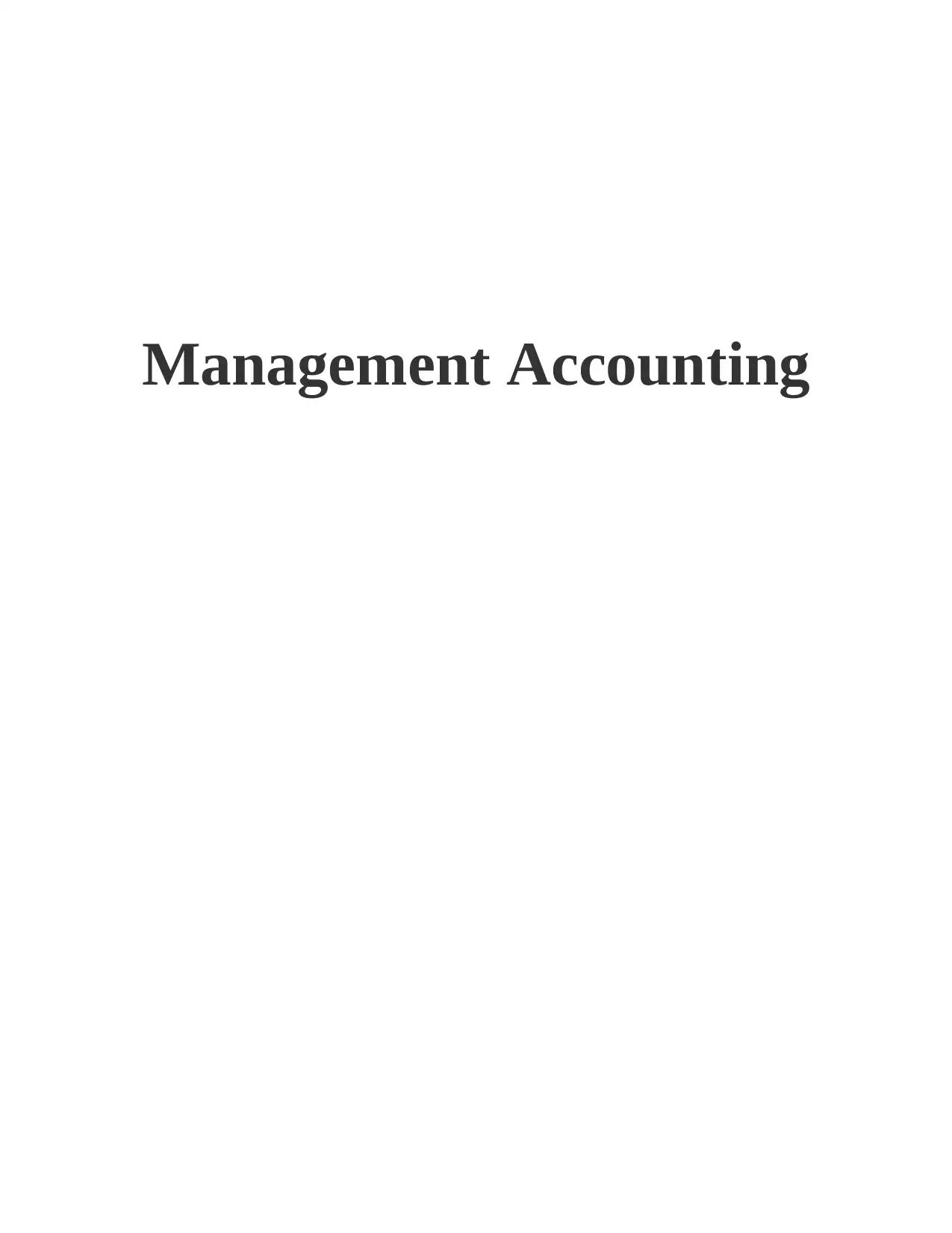
Management Accounting
Secure Best Marks with AI Grader
Need help grading? Try our AI Grader for instant feedback on your assignments.
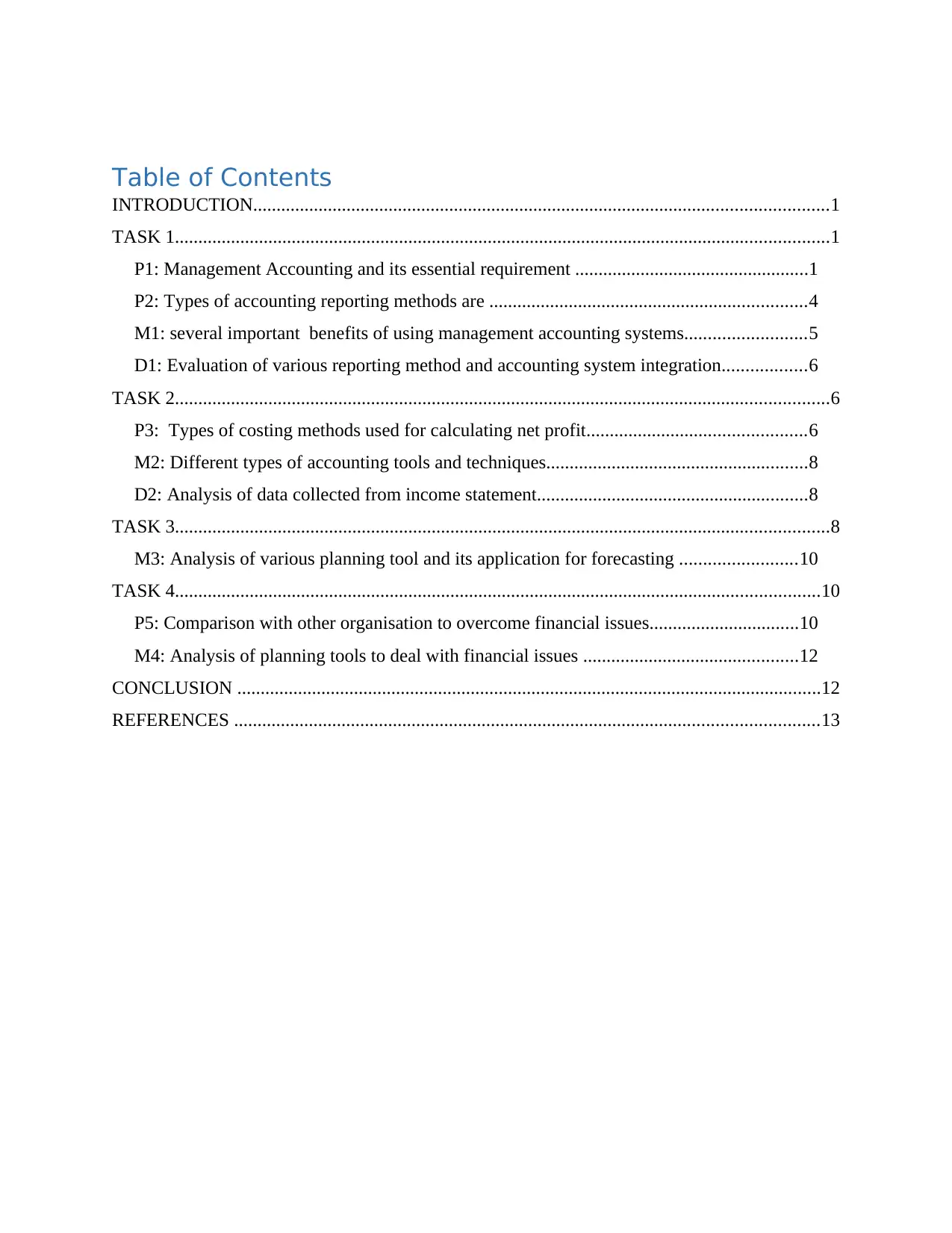
Table of Contents
INTRODUCTION...........................................................................................................................1
TASK 1............................................................................................................................................1
P1: Management Accounting and its essential requirement ..................................................1
P2: Types of accounting reporting methods are ....................................................................4
M1: several important benefits of using management accounting systems..........................5
D1: Evaluation of various reporting method and accounting system integration..................6
TASK 2............................................................................................................................................6
P3: Types of costing methods used for calculating net profit...............................................6
M2: Different types of accounting tools and techniques........................................................8
D2: Analysis of data collected from income statement..........................................................8
TASK 3............................................................................................................................................8
M3: Analysis of various planning tool and its application for forecasting .........................10
TASK 4..........................................................................................................................................10
P5: Comparison with other organisation to overcome financial issues................................10
M4: Analysis of planning tools to deal with financial issues ..............................................12
CONCLUSION .............................................................................................................................12
REFERENCES .............................................................................................................................13
INTRODUCTION...........................................................................................................................1
TASK 1............................................................................................................................................1
P1: Management Accounting and its essential requirement ..................................................1
P2: Types of accounting reporting methods are ....................................................................4
M1: several important benefits of using management accounting systems..........................5
D1: Evaluation of various reporting method and accounting system integration..................6
TASK 2............................................................................................................................................6
P3: Types of costing methods used for calculating net profit...............................................6
M2: Different types of accounting tools and techniques........................................................8
D2: Analysis of data collected from income statement..........................................................8
TASK 3............................................................................................................................................8
M3: Analysis of various planning tool and its application for forecasting .........................10
TASK 4..........................................................................................................................................10
P5: Comparison with other organisation to overcome financial issues................................10
M4: Analysis of planning tools to deal with financial issues ..............................................12
CONCLUSION .............................................................................................................................12
REFERENCES .............................................................................................................................13
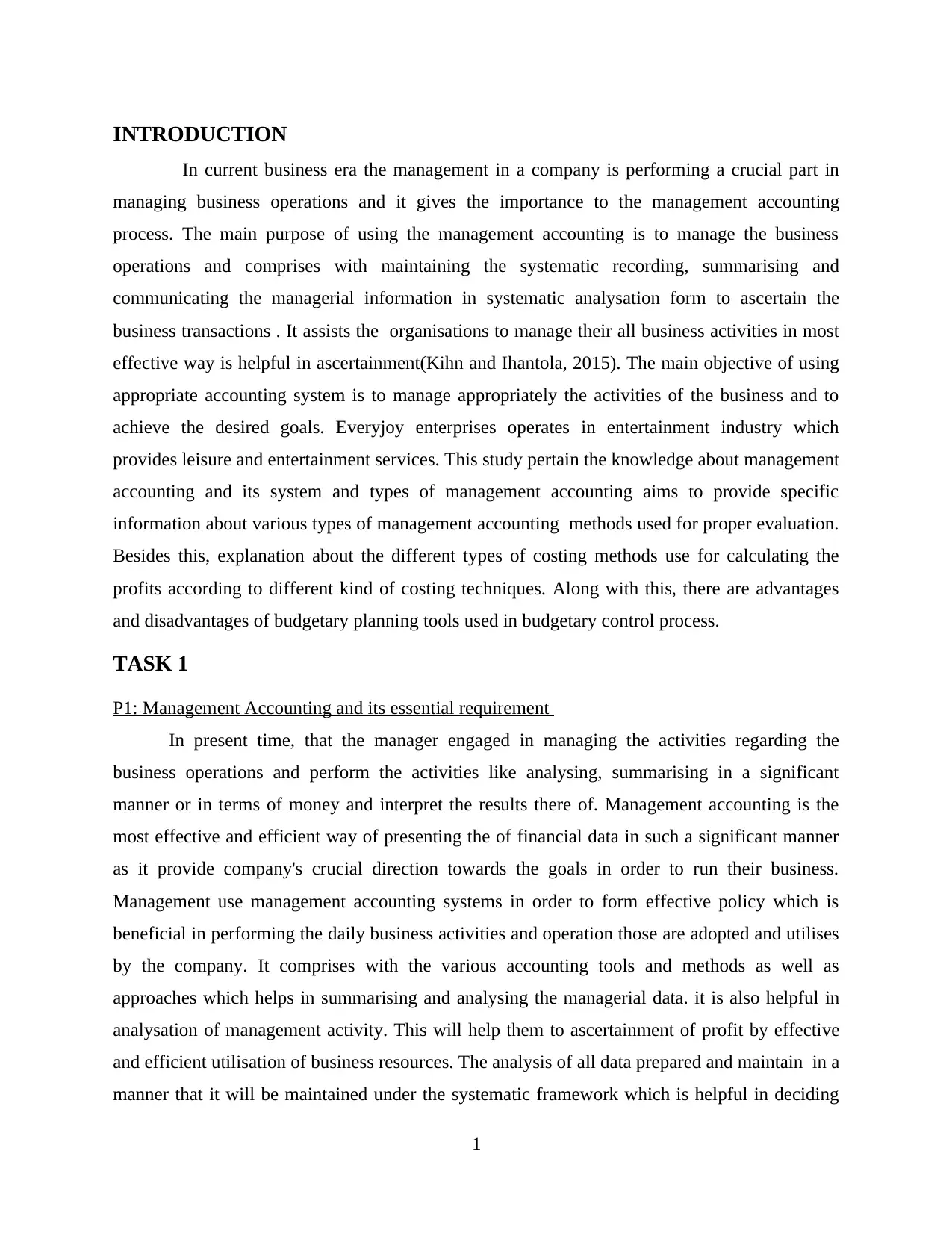
INTRODUCTION
In current business era the management in a company is performing a crucial part in
managing business operations and it gives the importance to the management accounting
process. The main purpose of using the management accounting is to manage the business
operations and comprises with maintaining the systematic recording, summarising and
communicating the managerial information in systematic analysation form to ascertain the
business transactions . It assists the organisations to manage their all business activities in most
effective way is helpful in ascertainment(Kihn and Ihantola, 2015). The main objective of using
appropriate accounting system is to manage appropriately the activities of the business and to
achieve the desired goals. Everyjoy enterprises operates in entertainment industry which
provides leisure and entertainment services. This study pertain the knowledge about management
accounting and its system and types of management accounting aims to provide specific
information about various types of management accounting methods used for proper evaluation.
Besides this, explanation about the different types of costing methods use for calculating the
profits according to different kind of costing techniques. Along with this, there are advantages
and disadvantages of budgetary planning tools used in budgetary control process.
TASK 1
P1: Management Accounting and its essential requirement
In present time, that the manager engaged in managing the activities regarding the
business operations and perform the activities like analysing, summarising in a significant
manner or in terms of money and interpret the results there of. Management accounting is the
most effective and efficient way of presenting the of financial data in such a significant manner
as it provide company's crucial direction towards the goals in order to run their business.
Management use management accounting systems in order to form effective policy which is
beneficial in performing the daily business activities and operation those are adopted and utilises
by the company. It comprises with the various accounting tools and methods as well as
approaches which helps in summarising and analysing the managerial data. it is also helpful in
analysation of management activity. This will help them to ascertainment of profit by effective
and efficient utilisation of business resources. The analysis of all data prepared and maintain in a
manner that it will be maintained under the systematic framework which is helpful in deciding
1
In current business era the management in a company is performing a crucial part in
managing business operations and it gives the importance to the management accounting
process. The main purpose of using the management accounting is to manage the business
operations and comprises with maintaining the systematic recording, summarising and
communicating the managerial information in systematic analysation form to ascertain the
business transactions . It assists the organisations to manage their all business activities in most
effective way is helpful in ascertainment(Kihn and Ihantola, 2015). The main objective of using
appropriate accounting system is to manage appropriately the activities of the business and to
achieve the desired goals. Everyjoy enterprises operates in entertainment industry which
provides leisure and entertainment services. This study pertain the knowledge about management
accounting and its system and types of management accounting aims to provide specific
information about various types of management accounting methods used for proper evaluation.
Besides this, explanation about the different types of costing methods use for calculating the
profits according to different kind of costing techniques. Along with this, there are advantages
and disadvantages of budgetary planning tools used in budgetary control process.
TASK 1
P1: Management Accounting and its essential requirement
In present time, that the manager engaged in managing the activities regarding the
business operations and perform the activities like analysing, summarising in a significant
manner or in terms of money and interpret the results there of. Management accounting is the
most effective and efficient way of presenting the of financial data in such a significant manner
as it provide company's crucial direction towards the goals in order to run their business.
Management use management accounting systems in order to form effective policy which is
beneficial in performing the daily business activities and operation those are adopted and utilises
by the company. It comprises with the various accounting tools and methods as well as
approaches which helps in summarising and analysing the managerial data. it is also helpful in
analysation of management activity. This will help them to ascertainment of profit by effective
and efficient utilisation of business resources. The analysis of all data prepared and maintain in a
manner that it will be maintained under the systematic framework which is helpful in deciding
1
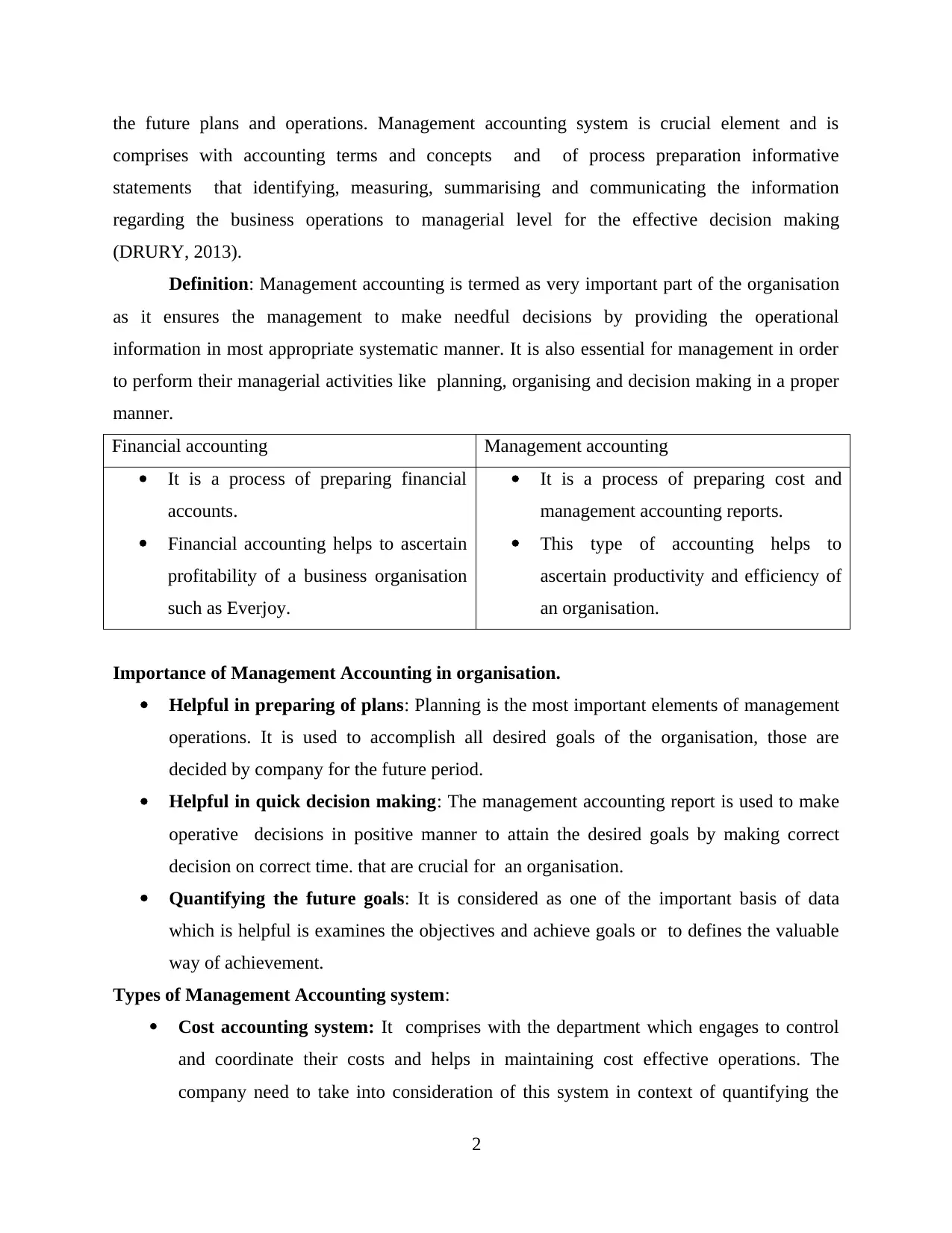
the future plans and operations. Management accounting system is crucial element and is
comprises with accounting terms and concepts and of process preparation informative
statements that identifying, measuring, summarising and communicating the information
regarding the business operations to managerial level for the effective decision making
(DRURY, 2013).
Definition: Management accounting is termed as very important part of the organisation
as it ensures the management to make needful decisions by providing the operational
information in most appropriate systematic manner. It is also essential for management in order
to perform their managerial activities like planning, organising and decision making in a proper
manner.
Financial accounting Management accounting
It is a process of preparing financial
accounts.
Financial accounting helps to ascertain
profitability of a business organisation
such as Everjoy.
It is a process of preparing cost and
management accounting reports.
This type of accounting helps to
ascertain productivity and efficiency of
an organisation.
Importance of Management Accounting in organisation.
Helpful in preparing of plans: Planning is the most important elements of management
operations. It is used to accomplish all desired goals of the organisation, those are
decided by company for the future period.
Helpful in quick decision making: The management accounting report is used to make
operative decisions in positive manner to attain the desired goals by making correct
decision on correct time. that are crucial for an organisation.
Quantifying the future goals: It is considered as one of the important basis of data
which is helpful is examines the objectives and achieve goals or to defines the valuable
way of achievement.
Types of Management Accounting system:
Cost accounting system: It comprises with the department which engages to control
and coordinate their costs and helps in maintaining cost effective operations. The
company need to take into consideration of this system in context of quantifying the
2
comprises with accounting terms and concepts and of process preparation informative
statements that identifying, measuring, summarising and communicating the information
regarding the business operations to managerial level for the effective decision making
(DRURY, 2013).
Definition: Management accounting is termed as very important part of the organisation
as it ensures the management to make needful decisions by providing the operational
information in most appropriate systematic manner. It is also essential for management in order
to perform their managerial activities like planning, organising and decision making in a proper
manner.
Financial accounting Management accounting
It is a process of preparing financial
accounts.
Financial accounting helps to ascertain
profitability of a business organisation
such as Everjoy.
It is a process of preparing cost and
management accounting reports.
This type of accounting helps to
ascertain productivity and efficiency of
an organisation.
Importance of Management Accounting in organisation.
Helpful in preparing of plans: Planning is the most important elements of management
operations. It is used to accomplish all desired goals of the organisation, those are
decided by company for the future period.
Helpful in quick decision making: The management accounting report is used to make
operative decisions in positive manner to attain the desired goals by making correct
decision on correct time. that are crucial for an organisation.
Quantifying the future goals: It is considered as one of the important basis of data
which is helpful is examines the objectives and achieve goals or to defines the valuable
way of achievement.
Types of Management Accounting system:
Cost accounting system: It comprises with the department which engages to control
and coordinate their costs and helps in maintaining cost effective operations. The
company need to take into consideration of this system in context of quantifying the
2
Secure Best Marks with AI Grader
Need help grading? Try our AI Grader for instant feedback on your assignments.
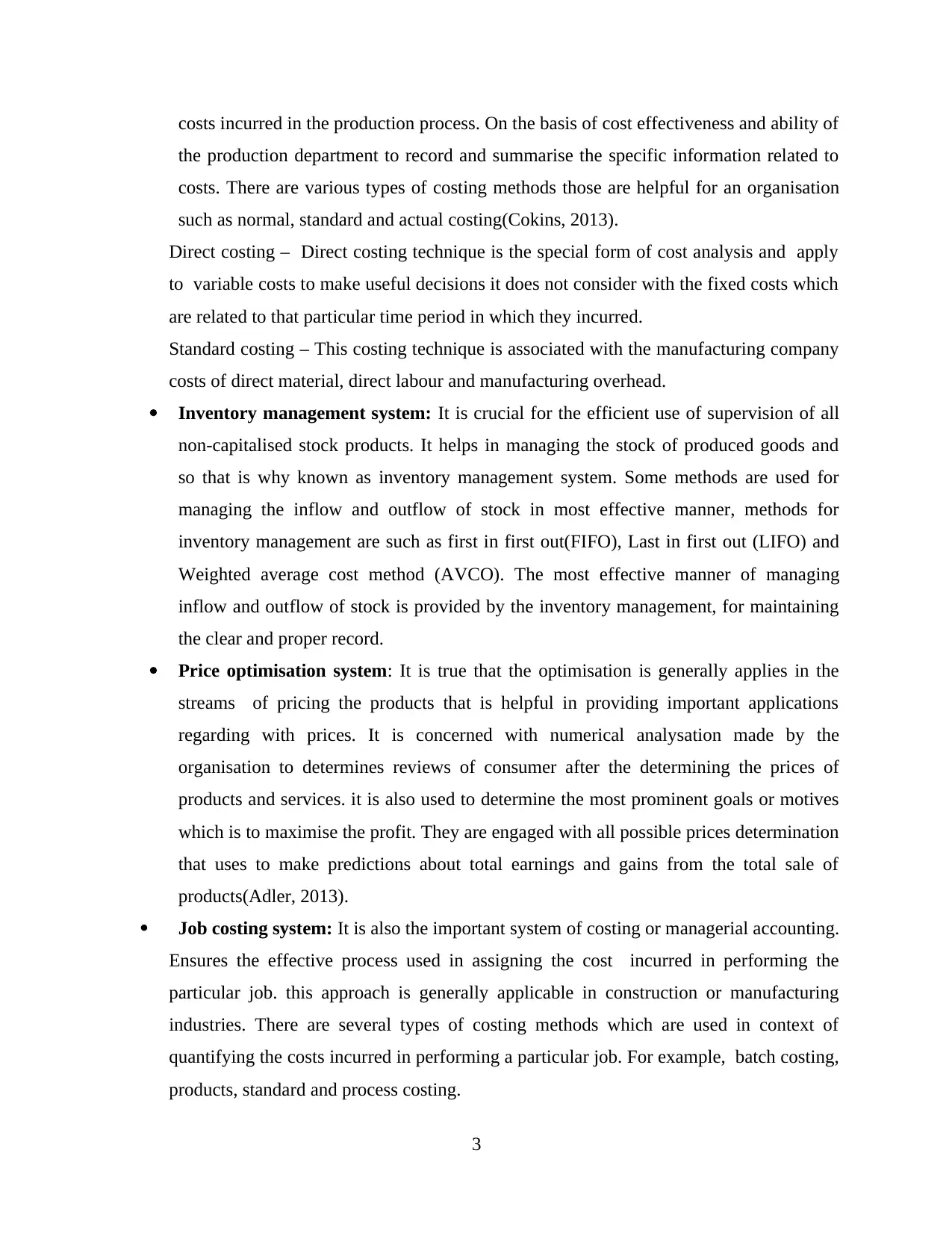
costs incurred in the production process. On the basis of cost effectiveness and ability of
the production department to record and summarise the specific information related to
costs. There are various types of costing methods those are helpful for an organisation
such as normal, standard and actual costing(Cokins, 2013).
Direct costing – Direct costing technique is the special form of cost analysis and apply
to variable costs to make useful decisions it does not consider with the fixed costs which
are related to that particular time period in which they incurred.
Standard costing – This costing technique is associated with the manufacturing company
costs of direct material, direct labour and manufacturing overhead.
Inventory management system: It is crucial for the efficient use of supervision of all
non-capitalised stock products. It helps in managing the stock of produced goods and
so that is why known as inventory management system. Some methods are used for
managing the inflow and outflow of stock in most effective manner, methods for
inventory management are such as first in first out(FIFO), Last in first out (LIFO) and
Weighted average cost method (AVCO). The most effective manner of managing
inflow and outflow of stock is provided by the inventory management, for maintaining
the clear and proper record.
Price optimisation system: It is true that the optimisation is generally applies in the
streams of pricing the products that is helpful in providing important applications
regarding with prices. It is concerned with numerical analysation made by the
organisation to determines reviews of consumer after the determining the prices of
products and services. it is also used to determine the most prominent goals or motives
which is to maximise the profit. They are engaged with all possible prices determination
that uses to make predictions about total earnings and gains from the total sale of
products(Adler, 2013).
Job costing system: It is also the important system of costing or managerial accounting.
Ensures the effective process used in assigning the cost incurred in performing the
particular job. this approach is generally applicable in construction or manufacturing
industries. There are several types of costing methods which are used in context of
quantifying the costs incurred in performing a particular job. For example, batch costing,
products, standard and process costing.
3
the production department to record and summarise the specific information related to
costs. There are various types of costing methods those are helpful for an organisation
such as normal, standard and actual costing(Cokins, 2013).
Direct costing – Direct costing technique is the special form of cost analysis and apply
to variable costs to make useful decisions it does not consider with the fixed costs which
are related to that particular time period in which they incurred.
Standard costing – This costing technique is associated with the manufacturing company
costs of direct material, direct labour and manufacturing overhead.
Inventory management system: It is crucial for the efficient use of supervision of all
non-capitalised stock products. It helps in managing the stock of produced goods and
so that is why known as inventory management system. Some methods are used for
managing the inflow and outflow of stock in most effective manner, methods for
inventory management are such as first in first out(FIFO), Last in first out (LIFO) and
Weighted average cost method (AVCO). The most effective manner of managing
inflow and outflow of stock is provided by the inventory management, for maintaining
the clear and proper record.
Price optimisation system: It is true that the optimisation is generally applies in the
streams of pricing the products that is helpful in providing important applications
regarding with prices. It is concerned with numerical analysation made by the
organisation to determines reviews of consumer after the determining the prices of
products and services. it is also used to determine the most prominent goals or motives
which is to maximise the profit. They are engaged with all possible prices determination
that uses to make predictions about total earnings and gains from the total sale of
products(Adler, 2013).
Job costing system: It is also the important system of costing or managerial accounting.
Ensures the effective process used in assigning the cost incurred in performing the
particular job. this approach is generally applicable in construction or manufacturing
industries. There are several types of costing methods which are used in context of
quantifying the costs incurred in performing a particular job. For example, batch costing,
products, standard and process costing.
3
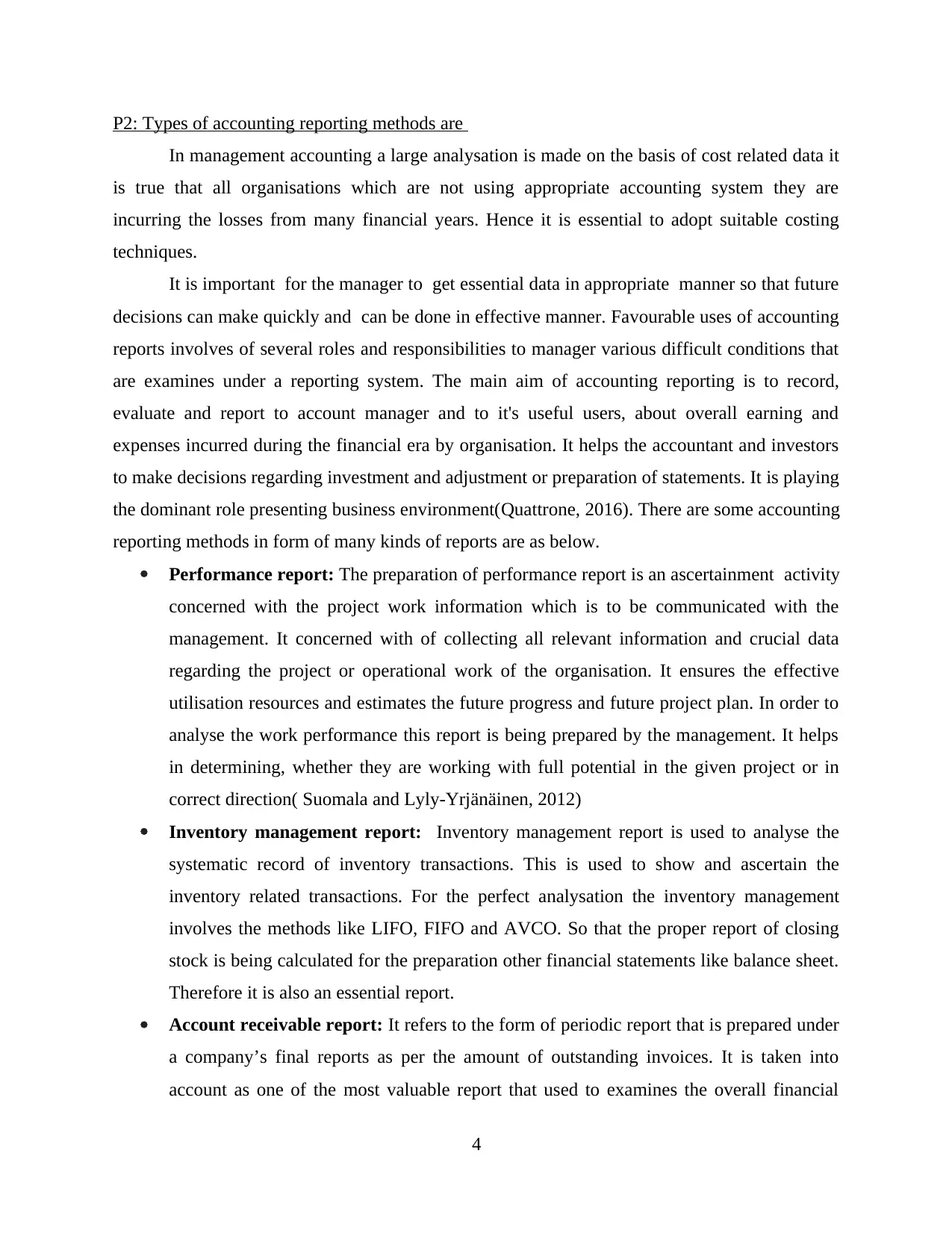
P2: Types of accounting reporting methods are
In management accounting a large analysation is made on the basis of cost related data it
is true that all organisations which are not using appropriate accounting system they are
incurring the losses from many financial years. Hence it is essential to adopt suitable costing
techniques.
It is important for the manager to get essential data in appropriate manner so that future
decisions can make quickly and can be done in effective manner. Favourable uses of accounting
reports involves of several roles and responsibilities to manager various difficult conditions that
are examines under a reporting system. The main aim of accounting reporting is to record,
evaluate and report to account manager and to it's useful users, about overall earning and
expenses incurred during the financial era by organisation. It helps the accountant and investors
to make decisions regarding investment and adjustment or preparation of statements. It is playing
the dominant role presenting business environment(Quattrone, 2016). There are some accounting
reporting methods in form of many kinds of reports are as below.
Performance report: The preparation of performance report is an ascertainment activity
concerned with the project work information which is to be communicated with the
management. It concerned with of collecting all relevant information and crucial data
regarding the project or operational work of the organisation. It ensures the effective
utilisation resources and estimates the future progress and future project plan. In order to
analyse the work performance this report is being prepared by the management. It helps
in determining, whether they are working with full potential in the given project or in
correct direction( Suomala and Lyly-Yrjänäinen, 2012)
Inventory management report: Inventory management report is used to analyse the
systematic record of inventory transactions. This is used to show and ascertain the
inventory related transactions. For the perfect analysation the inventory management
involves the methods like LIFO, FIFO and AVCO. So that the proper report of closing
stock is being calculated for the preparation other financial statements like balance sheet.
Therefore it is also an essential report.
Account receivable report: It refers to the form of periodic report that is prepared under
a company’s final reports as per the amount of outstanding invoices. It is taken into
account as one of the most valuable report that used to examines the overall financial
4
In management accounting a large analysation is made on the basis of cost related data it
is true that all organisations which are not using appropriate accounting system they are
incurring the losses from many financial years. Hence it is essential to adopt suitable costing
techniques.
It is important for the manager to get essential data in appropriate manner so that future
decisions can make quickly and can be done in effective manner. Favourable uses of accounting
reports involves of several roles and responsibilities to manager various difficult conditions that
are examines under a reporting system. The main aim of accounting reporting is to record,
evaluate and report to account manager and to it's useful users, about overall earning and
expenses incurred during the financial era by organisation. It helps the accountant and investors
to make decisions regarding investment and adjustment or preparation of statements. It is playing
the dominant role presenting business environment(Quattrone, 2016). There are some accounting
reporting methods in form of many kinds of reports are as below.
Performance report: The preparation of performance report is an ascertainment activity
concerned with the project work information which is to be communicated with the
management. It concerned with of collecting all relevant information and crucial data
regarding the project or operational work of the organisation. It ensures the effective
utilisation resources and estimates the future progress and future project plan. In order to
analyse the work performance this report is being prepared by the management. It helps
in determining, whether they are working with full potential in the given project or in
correct direction( Suomala and Lyly-Yrjänäinen, 2012)
Inventory management report: Inventory management report is used to analyse the
systematic record of inventory transactions. This is used to show and ascertain the
inventory related transactions. For the perfect analysation the inventory management
involves the methods like LIFO, FIFO and AVCO. So that the proper report of closing
stock is being calculated for the preparation other financial statements like balance sheet.
Therefore it is also an essential report.
Account receivable report: It refers to the form of periodic report that is prepared under
a company’s final reports as per the amount of outstanding invoices. It is taken into
account as one of the most valuable report that used to examines the overall financial
4
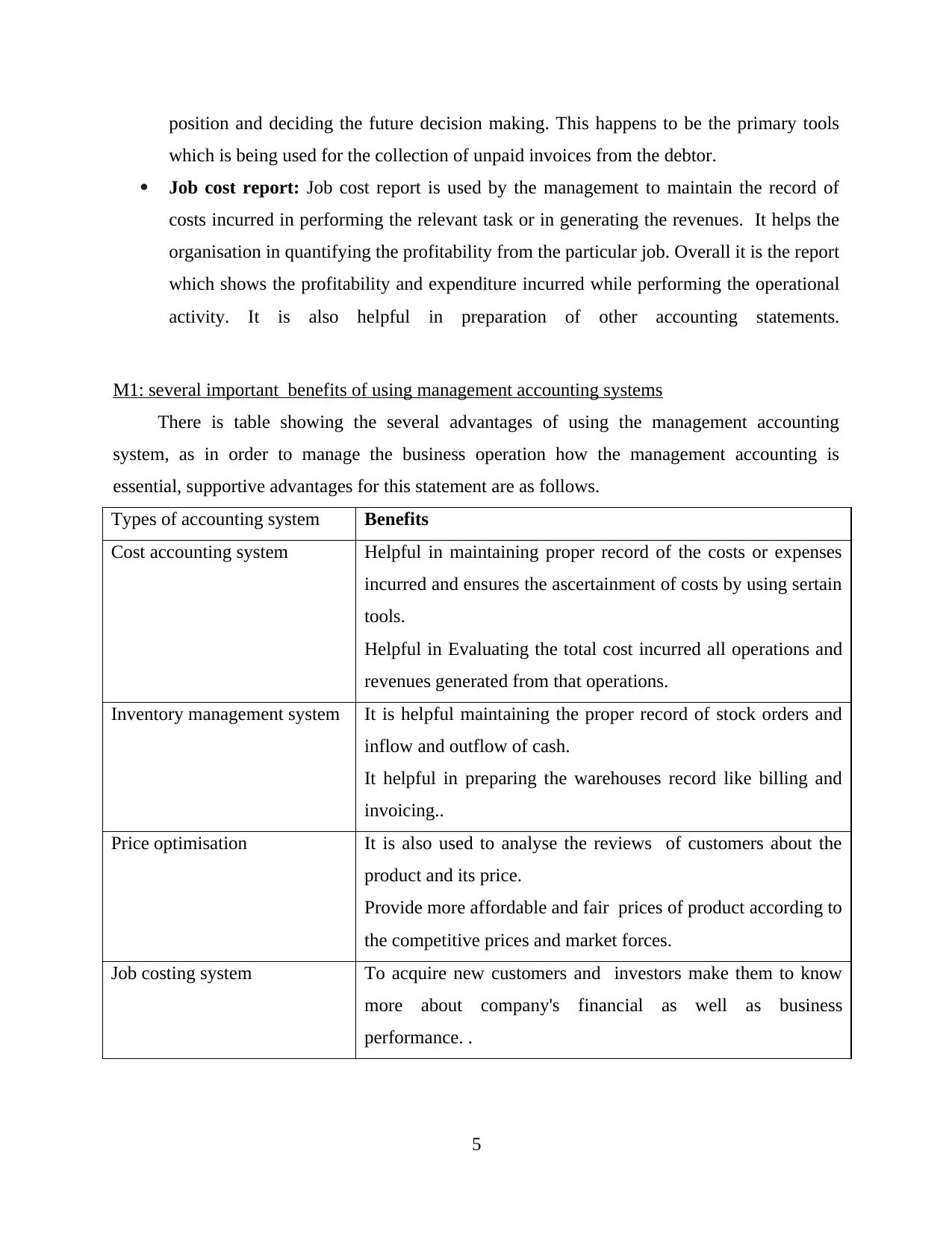
position and deciding the future decision making. This happens to be the primary tools
which is being used for the collection of unpaid invoices from the debtor.
Job cost report: Job cost report is used by the management to maintain the record of
costs incurred in performing the relevant task or in generating the revenues. It helps the
organisation in quantifying the profitability from the particular job. Overall it is the report
which shows the profitability and expenditure incurred while performing the operational
activity. It is also helpful in preparation of other accounting statements.
M1: several important benefits of using management accounting systems
There is table showing the several advantages of using the management accounting
system, as in order to manage the business operation how the management accounting is
essential, supportive advantages for this statement are as follows.
Types of accounting system Benefits
Cost accounting system Helpful in maintaining proper record of the costs or expenses
incurred and ensures the ascertainment of costs by using sertain
tools.
Helpful in Evaluating the total cost incurred all operations and
revenues generated from that operations.
Inventory management system It is helpful maintaining the proper record of stock orders and
inflow and outflow of cash.
It helpful in preparing the warehouses record like billing and
invoicing..
Price optimisation It is also used to analyse the reviews of customers about the
product and its price.
Provide more affordable and fair prices of product according to
the competitive prices and market forces.
Job costing system To acquire new customers and investors make them to know
more about company's financial as well as business
performance. .
5
which is being used for the collection of unpaid invoices from the debtor.
Job cost report: Job cost report is used by the management to maintain the record of
costs incurred in performing the relevant task or in generating the revenues. It helps the
organisation in quantifying the profitability from the particular job. Overall it is the report
which shows the profitability and expenditure incurred while performing the operational
activity. It is also helpful in preparation of other accounting statements.
M1: several important benefits of using management accounting systems
There is table showing the several advantages of using the management accounting
system, as in order to manage the business operation how the management accounting is
essential, supportive advantages for this statement are as follows.
Types of accounting system Benefits
Cost accounting system Helpful in maintaining proper record of the costs or expenses
incurred and ensures the ascertainment of costs by using sertain
tools.
Helpful in Evaluating the total cost incurred all operations and
revenues generated from that operations.
Inventory management system It is helpful maintaining the proper record of stock orders and
inflow and outflow of cash.
It helpful in preparing the warehouses record like billing and
invoicing..
Price optimisation It is also used to analyse the reviews of customers about the
product and its price.
Provide more affordable and fair prices of product according to
the competitive prices and market forces.
Job costing system To acquire new customers and investors make them to know
more about company's financial as well as business
performance. .
5
Paraphrase This Document
Need a fresh take? Get an instant paraphrase of this document with our AI Paraphraser
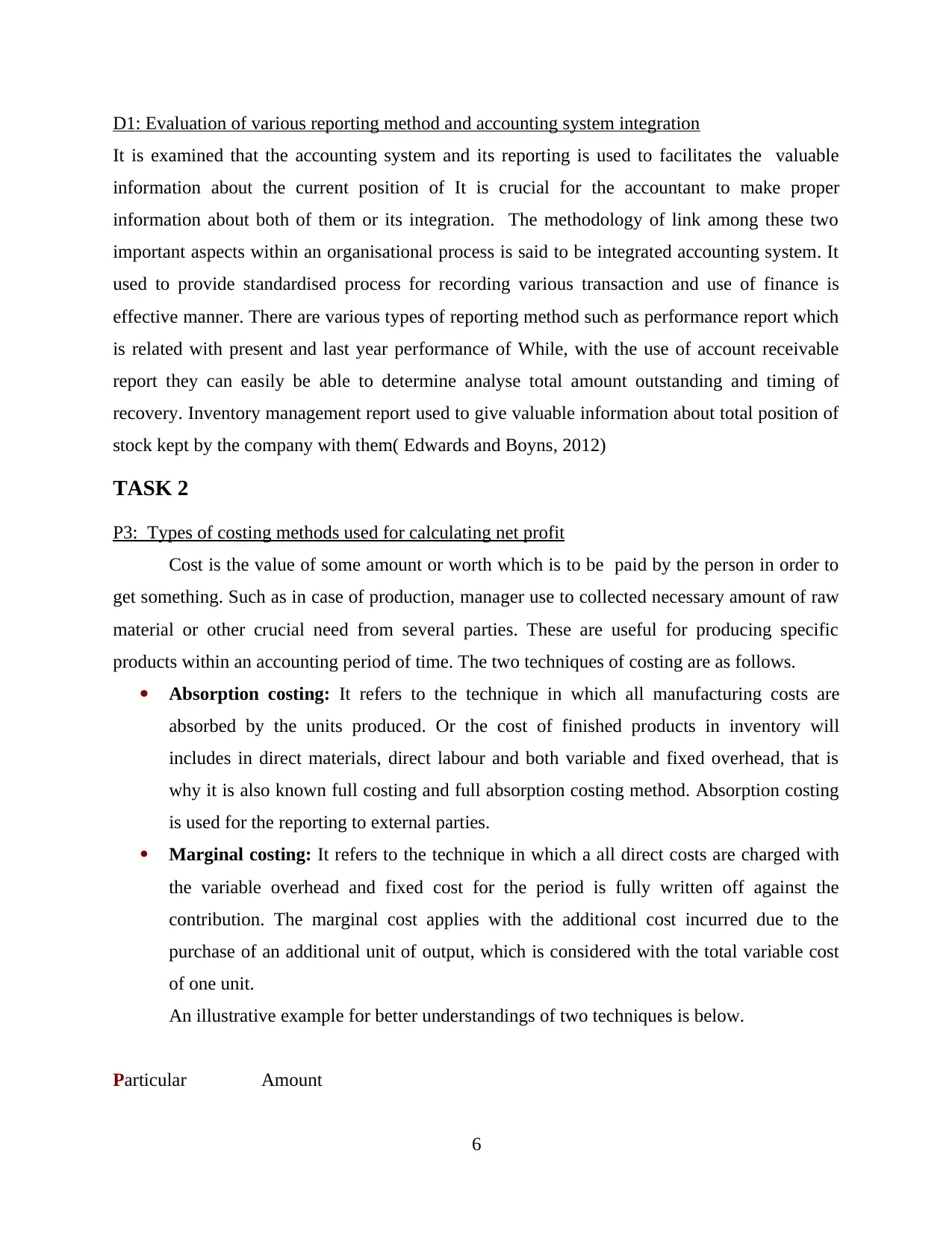
D1: Evaluation of various reporting method and accounting system integration
It is examined that the accounting system and its reporting is used to facilitates the valuable
information about the current position of It is crucial for the accountant to make proper
information about both of them or its integration. The methodology of link among these two
important aspects within an organisational process is said to be integrated accounting system. It
used to provide standardised process for recording various transaction and use of finance is
effective manner. There are various types of reporting method such as performance report which
is related with present and last year performance of While, with the use of account receivable
report they can easily be able to determine analyse total amount outstanding and timing of
recovery. Inventory management report used to give valuable information about total position of
stock kept by the company with them( Edwards and Boyns, 2012)
TASK 2
P3: Types of costing methods used for calculating net profit
Cost is the value of some amount or worth which is to be paid by the person in order to
get something. Such as in case of production, manager use to collected necessary amount of raw
material or other crucial need from several parties. These are useful for producing specific
products within an accounting period of time. The two techniques of costing are as follows.
Absorption costing: It refers to the technique in which all manufacturing costs are
absorbed by the units produced. Or the cost of finished products in inventory will
includes in direct materials, direct labour and both variable and fixed overhead, that is
why it is also known full costing and full absorption costing method. Absorption costing
is used for the reporting to external parties.
Marginal costing: It refers to the technique in which a all direct costs are charged with
the variable overhead and fixed cost for the period is fully written off against the
contribution. The marginal cost applies with the additional cost incurred due to the
purchase of an additional unit of output, which is considered with the total variable cost
of one unit.
An illustrative example for better understandings of two techniques is below.
Particular Amount
6
It is examined that the accounting system and its reporting is used to facilitates the valuable
information about the current position of It is crucial for the accountant to make proper
information about both of them or its integration. The methodology of link among these two
important aspects within an organisational process is said to be integrated accounting system. It
used to provide standardised process for recording various transaction and use of finance is
effective manner. There are various types of reporting method such as performance report which
is related with present and last year performance of While, with the use of account receivable
report they can easily be able to determine analyse total amount outstanding and timing of
recovery. Inventory management report used to give valuable information about total position of
stock kept by the company with them( Edwards and Boyns, 2012)
TASK 2
P3: Types of costing methods used for calculating net profit
Cost is the value of some amount or worth which is to be paid by the person in order to
get something. Such as in case of production, manager use to collected necessary amount of raw
material or other crucial need from several parties. These are useful for producing specific
products within an accounting period of time. The two techniques of costing are as follows.
Absorption costing: It refers to the technique in which all manufacturing costs are
absorbed by the units produced. Or the cost of finished products in inventory will
includes in direct materials, direct labour and both variable and fixed overhead, that is
why it is also known full costing and full absorption costing method. Absorption costing
is used for the reporting to external parties.
Marginal costing: It refers to the technique in which a all direct costs are charged with
the variable overhead and fixed cost for the period is fully written off against the
contribution. The marginal cost applies with the additional cost incurred due to the
purchase of an additional unit of output, which is considered with the total variable cost
of one unit.
An illustrative example for better understandings of two techniques is below.
Particular Amount
6
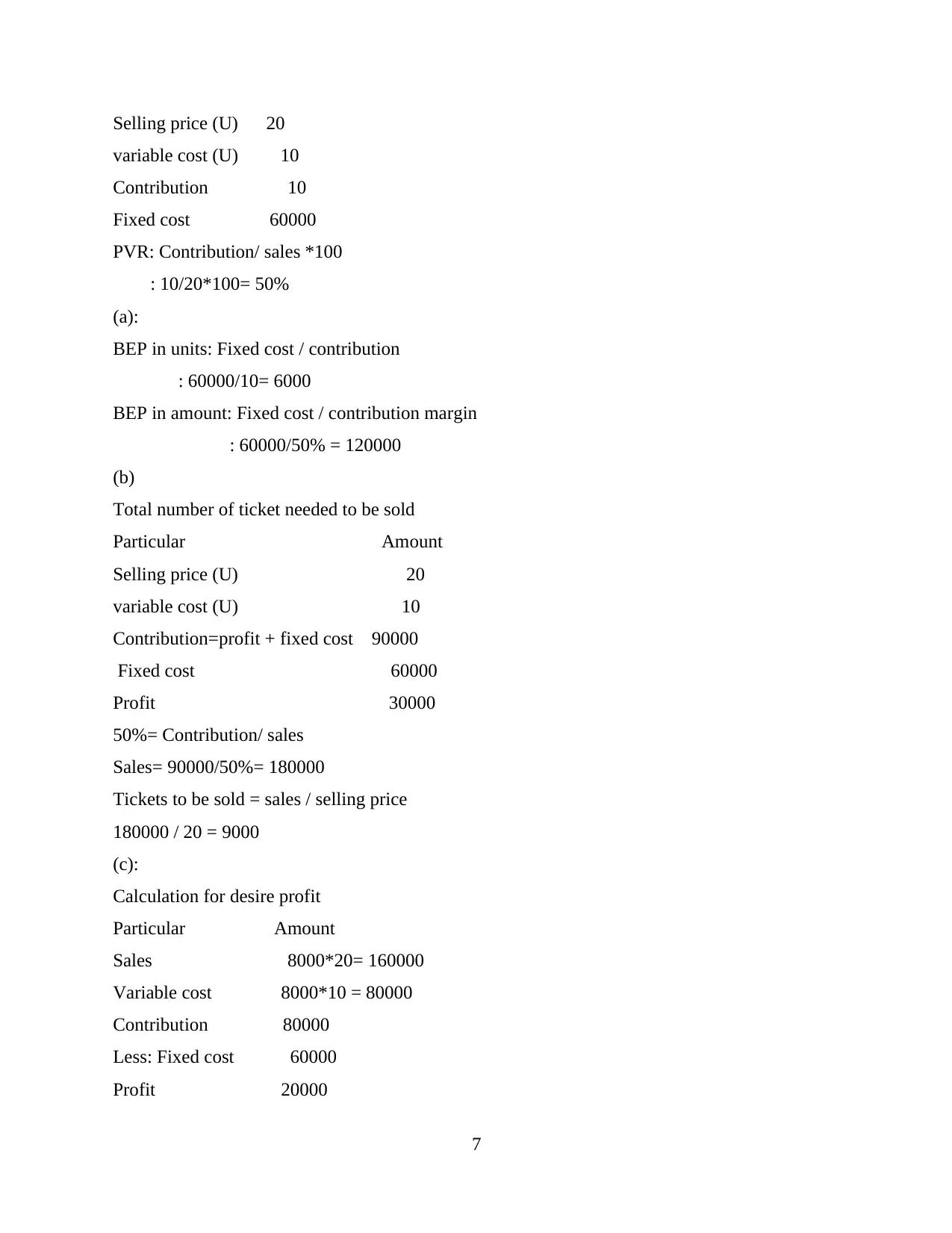
Selling price (U) 20
variable cost (U) 10
Contribution 10
Fixed cost 60000
PVR: Contribution/ sales *100
: 10/20*100= 50%
(a):
BEP in units: Fixed cost / contribution
: 60000/10= 6000
BEP in amount: Fixed cost / contribution margin
: 60000/50% = 120000
(b)
Total number of ticket needed to be sold
Particular Amount
Selling price (U) 20
variable cost (U) 10
Contribution=profit + fixed cost 90000
Fixed cost 60000
Profit 30000
50%= Contribution/ sales
Sales= 90000/50%= 180000
Tickets to be sold = sales / selling price
180000 / 20 = 9000
(c):
Calculation for desire profit
Particular Amount
Sales 8000*20= 160000
Variable cost 8000*10 = 80000
Contribution 80000
Less: Fixed cost 60000
Profit 20000
7
variable cost (U) 10
Contribution 10
Fixed cost 60000
PVR: Contribution/ sales *100
: 10/20*100= 50%
(a):
BEP in units: Fixed cost / contribution
: 60000/10= 6000
BEP in amount: Fixed cost / contribution margin
: 60000/50% = 120000
(b)
Total number of ticket needed to be sold
Particular Amount
Selling price (U) 20
variable cost (U) 10
Contribution=profit + fixed cost 90000
Fixed cost 60000
Profit 30000
50%= Contribution/ sales
Sales= 90000/50%= 180000
Tickets to be sold = sales / selling price
180000 / 20 = 9000
(c):
Calculation for desire profit
Particular Amount
Sales 8000*20= 160000
Variable cost 8000*10 = 80000
Contribution 80000
Less: Fixed cost 60000
Profit 20000
7
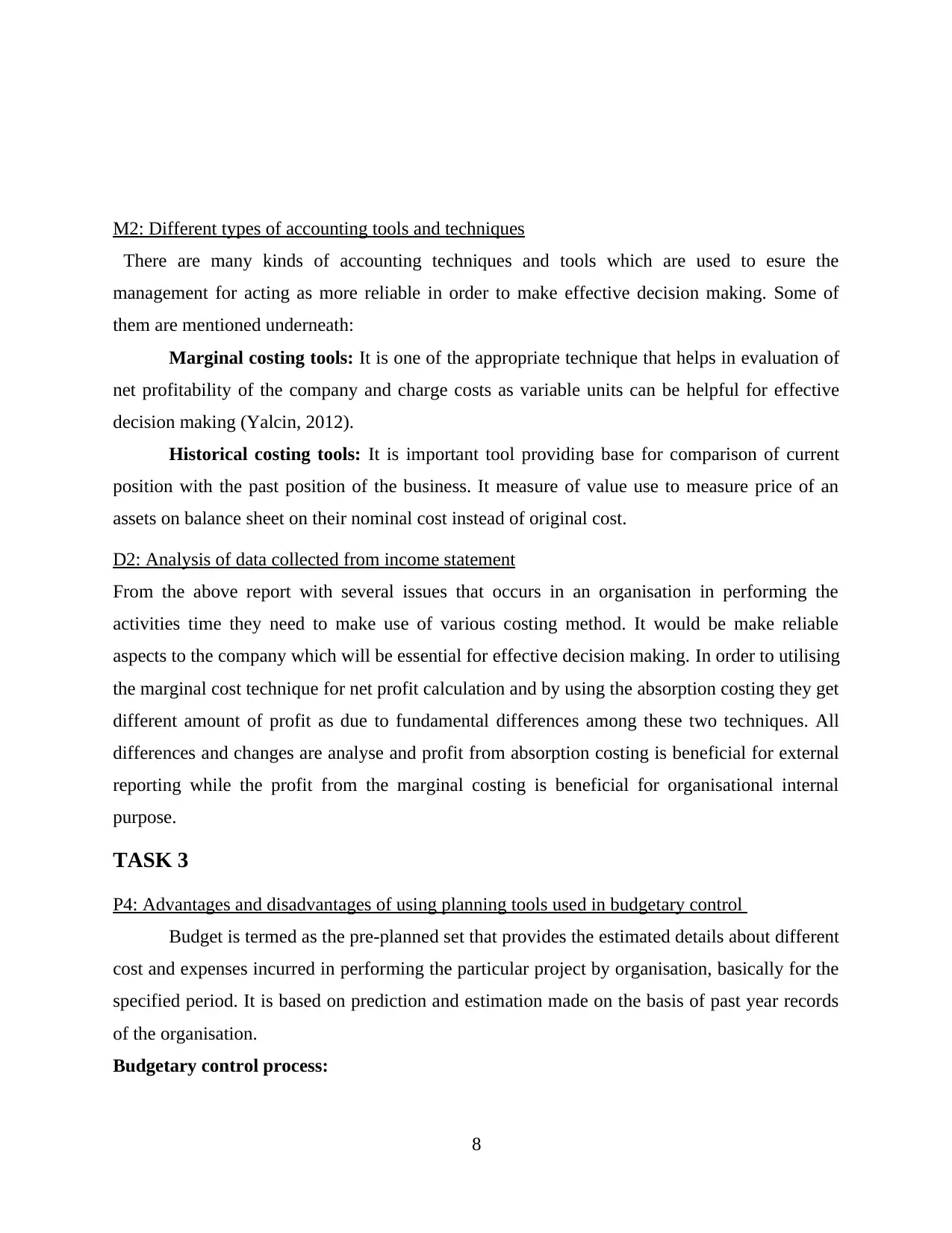
M2: Different types of accounting tools and techniques
There are many kinds of accounting techniques and tools which are used to esure the
management for acting as more reliable in order to make effective decision making. Some of
them are mentioned underneath:
Marginal costing tools: It is one of the appropriate technique that helps in evaluation of
net profitability of the company and charge costs as variable units can be helpful for effective
decision making (Yalcin, 2012).
Historical costing tools: It is important tool providing base for comparison of current
position with the past position of the business. It measure of value use to measure price of an
assets on balance sheet on their nominal cost instead of original cost.
D2: Analysis of data collected from income statement
From the above report with several issues that occurs in an organisation in performing the
activities time they need to make use of various costing method. It would be make reliable
aspects to the company which will be essential for effective decision making. In order to utilising
the marginal cost technique for net profit calculation and by using the absorption costing they get
different amount of profit as due to fundamental differences among these two techniques. All
differences and changes are analyse and profit from absorption costing is beneficial for external
reporting while the profit from the marginal costing is beneficial for organisational internal
purpose.
TASK 3
P4: Advantages and disadvantages of using planning tools used in budgetary control
Budget is termed as the pre-planned set that provides the estimated details about different
cost and expenses incurred in performing the particular project by organisation, basically for the
specified period. It is based on prediction and estimation made on the basis of past year records
of the organisation.
Budgetary control process:
8
There are many kinds of accounting techniques and tools which are used to esure the
management for acting as more reliable in order to make effective decision making. Some of
them are mentioned underneath:
Marginal costing tools: It is one of the appropriate technique that helps in evaluation of
net profitability of the company and charge costs as variable units can be helpful for effective
decision making (Yalcin, 2012).
Historical costing tools: It is important tool providing base for comparison of current
position with the past position of the business. It measure of value use to measure price of an
assets on balance sheet on their nominal cost instead of original cost.
D2: Analysis of data collected from income statement
From the above report with several issues that occurs in an organisation in performing the
activities time they need to make use of various costing method. It would be make reliable
aspects to the company which will be essential for effective decision making. In order to utilising
the marginal cost technique for net profit calculation and by using the absorption costing they get
different amount of profit as due to fundamental differences among these two techniques. All
differences and changes are analyse and profit from absorption costing is beneficial for external
reporting while the profit from the marginal costing is beneficial for organisational internal
purpose.
TASK 3
P4: Advantages and disadvantages of using planning tools used in budgetary control
Budget is termed as the pre-planned set that provides the estimated details about different
cost and expenses incurred in performing the particular project by organisation, basically for the
specified period. It is based on prediction and estimation made on the basis of past year records
of the organisation.
Budgetary control process:
8
Secure Best Marks with AI Grader
Need help grading? Try our AI Grader for instant feedback on your assignments.
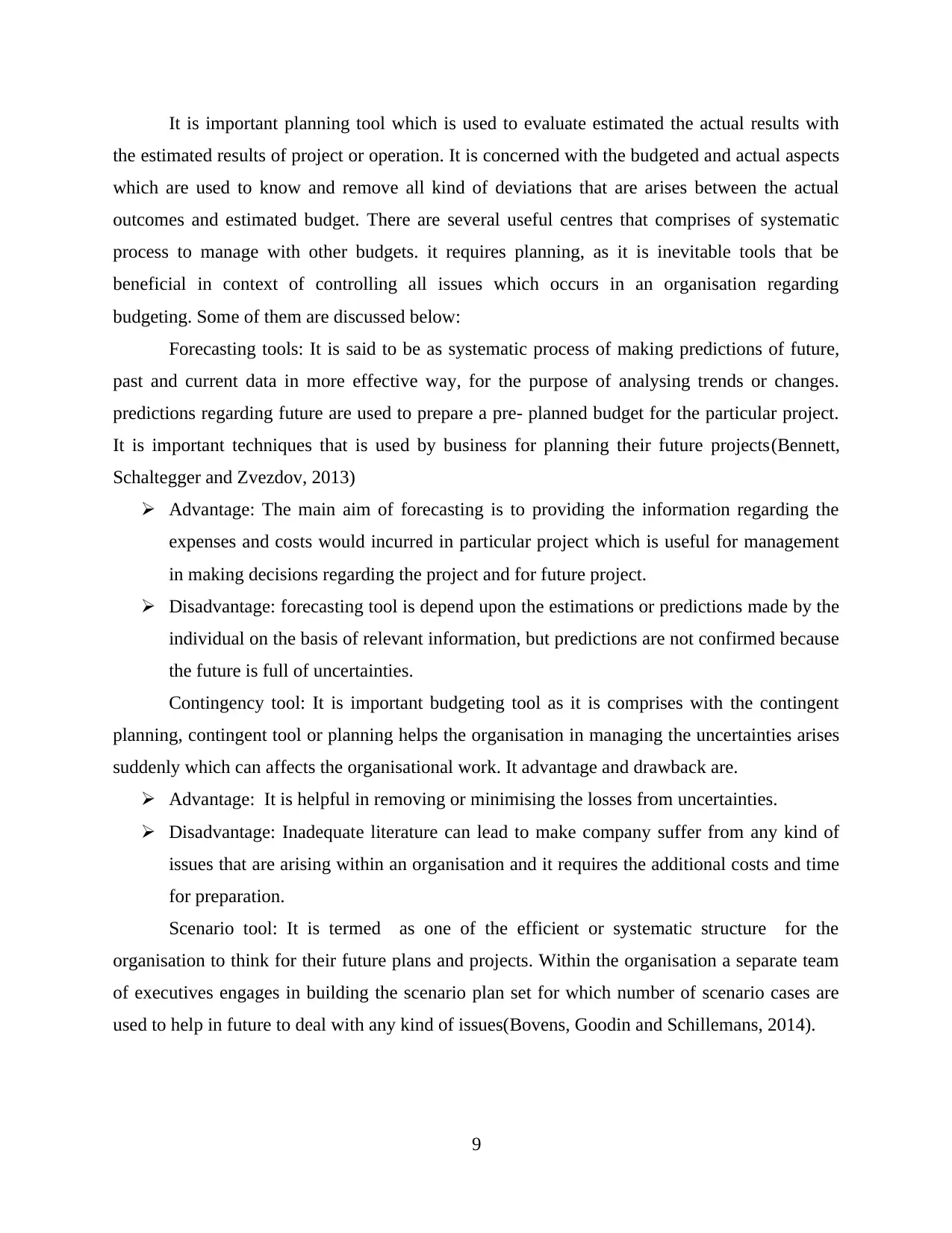
It is important planning tool which is used to evaluate estimated the actual results with
the estimated results of project or operation. It is concerned with the budgeted and actual aspects
which are used to know and remove all kind of deviations that are arises between the actual
outcomes and estimated budget. There are several useful centres that comprises of systematic
process to manage with other budgets. it requires planning, as it is inevitable tools that be
beneficial in context of controlling all issues which occurs in an organisation regarding
budgeting. Some of them are discussed below:
Forecasting tools: It is said to be as systematic process of making predictions of future,
past and current data in more effective way, for the purpose of analysing trends or changes.
predictions regarding future are used to prepare a pre- planned budget for the particular project.
It is important techniques that is used by business for planning their future projects(Bennett,
Schaltegger and Zvezdov, 2013)
Advantage: The main aim of forecasting is to providing the information regarding the
expenses and costs would incurred in particular project which is useful for management
in making decisions regarding the project and for future project.
Disadvantage: forecasting tool is depend upon the estimations or predictions made by the
individual on the basis of relevant information, but predictions are not confirmed because
the future is full of uncertainties.
Contingency tool: It is important budgeting tool as it is comprises with the contingent
planning, contingent tool or planning helps the organisation in managing the uncertainties arises
suddenly which can affects the organisational work. It advantage and drawback are.
Advantage: It is helpful in removing or minimising the losses from uncertainties.
Disadvantage: Inadequate literature can lead to make company suffer from any kind of
issues that are arising within an organisation and it requires the additional costs and time
for preparation.
Scenario tool: It is termed as one of the efficient or systematic structure for the
organisation to think for their future plans and projects. Within the organisation a separate team
of executives engages in building the scenario plan set for which number of scenario cases are
used to help in future to deal with any kind of issues(Bovens, Goodin and Schillemans, 2014).
9
the estimated results of project or operation. It is concerned with the budgeted and actual aspects
which are used to know and remove all kind of deviations that are arises between the actual
outcomes and estimated budget. There are several useful centres that comprises of systematic
process to manage with other budgets. it requires planning, as it is inevitable tools that be
beneficial in context of controlling all issues which occurs in an organisation regarding
budgeting. Some of them are discussed below:
Forecasting tools: It is said to be as systematic process of making predictions of future,
past and current data in more effective way, for the purpose of analysing trends or changes.
predictions regarding future are used to prepare a pre- planned budget for the particular project.
It is important techniques that is used by business for planning their future projects(Bennett,
Schaltegger and Zvezdov, 2013)
Advantage: The main aim of forecasting is to providing the information regarding the
expenses and costs would incurred in particular project which is useful for management
in making decisions regarding the project and for future project.
Disadvantage: forecasting tool is depend upon the estimations or predictions made by the
individual on the basis of relevant information, but predictions are not confirmed because
the future is full of uncertainties.
Contingency tool: It is important budgeting tool as it is comprises with the contingent
planning, contingent tool or planning helps the organisation in managing the uncertainties arises
suddenly which can affects the organisational work. It advantage and drawback are.
Advantage: It is helpful in removing or minimising the losses from uncertainties.
Disadvantage: Inadequate literature can lead to make company suffer from any kind of
issues that are arising within an organisation and it requires the additional costs and time
for preparation.
Scenario tool: It is termed as one of the efficient or systematic structure for the
organisation to think for their future plans and projects. Within the organisation a separate team
of executives engages in building the scenario plan set for which number of scenario cases are
used to help in future to deal with any kind of issues(Bovens, Goodin and Schillemans, 2014).
9
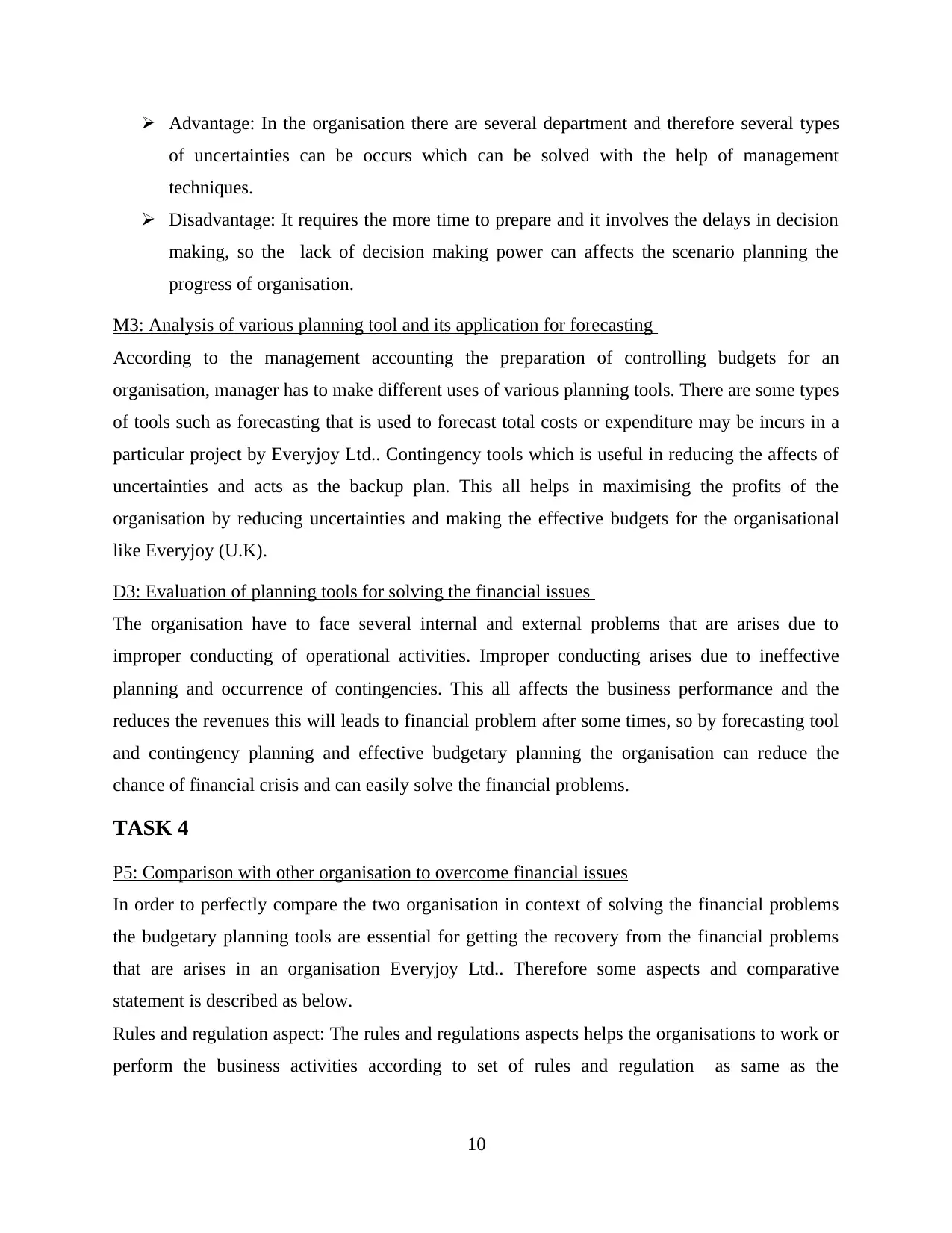
Advantage: In the organisation there are several department and therefore several types
of uncertainties can be occurs which can be solved with the help of management
techniques.
Disadvantage: It requires the more time to prepare and it involves the delays in decision
making, so the lack of decision making power can affects the scenario planning the
progress of organisation.
M3: Analysis of various planning tool and its application for forecasting
According to the management accounting the preparation of controlling budgets for an
organisation, manager has to make different uses of various planning tools. There are some types
of tools such as forecasting that is used to forecast total costs or expenditure may be incurs in a
particular project by Everyjoy Ltd.. Contingency tools which is useful in reducing the affects of
uncertainties and acts as the backup plan. This all helps in maximising the profits of the
organisation by reducing uncertainties and making the effective budgets for the organisational
like Everyjoy (U.K).
D3: Evaluation of planning tools for solving the financial issues
The organisation have to face several internal and external problems that are arises due to
improper conducting of operational activities. Improper conducting arises due to ineffective
planning and occurrence of contingencies. This all affects the business performance and the
reduces the revenues this will leads to financial problem after some times, so by forecasting tool
and contingency planning and effective budgetary planning the organisation can reduce the
chance of financial crisis and can easily solve the financial problems.
TASK 4
P5: Comparison with other organisation to overcome financial issues
In order to perfectly compare the two organisation in context of solving the financial problems
the budgetary planning tools are essential for getting the recovery from the financial problems
that are arises in an organisation Everyjoy Ltd.. Therefore some aspects and comparative
statement is described as below.
Rules and regulation aspect: The rules and regulations aspects helps the organisations to work or
perform the business activities according to set of rules and regulation as same as the
10
of uncertainties can be occurs which can be solved with the help of management
techniques.
Disadvantage: It requires the more time to prepare and it involves the delays in decision
making, so the lack of decision making power can affects the scenario planning the
progress of organisation.
M3: Analysis of various planning tool and its application for forecasting
According to the management accounting the preparation of controlling budgets for an
organisation, manager has to make different uses of various planning tools. There are some types
of tools such as forecasting that is used to forecast total costs or expenditure may be incurs in a
particular project by Everyjoy Ltd.. Contingency tools which is useful in reducing the affects of
uncertainties and acts as the backup plan. This all helps in maximising the profits of the
organisation by reducing uncertainties and making the effective budgets for the organisational
like Everyjoy (U.K).
D3: Evaluation of planning tools for solving the financial issues
The organisation have to face several internal and external problems that are arises due to
improper conducting of operational activities. Improper conducting arises due to ineffective
planning and occurrence of contingencies. This all affects the business performance and the
reduces the revenues this will leads to financial problem after some times, so by forecasting tool
and contingency planning and effective budgetary planning the organisation can reduce the
chance of financial crisis and can easily solve the financial problems.
TASK 4
P5: Comparison with other organisation to overcome financial issues
In order to perfectly compare the two organisation in context of solving the financial problems
the budgetary planning tools are essential for getting the recovery from the financial problems
that are arises in an organisation Everyjoy Ltd.. Therefore some aspects and comparative
statement is described as below.
Rules and regulation aspect: The rules and regulations aspects helps the organisations to work or
perform the business activities according to set of rules and regulation as same as the
10
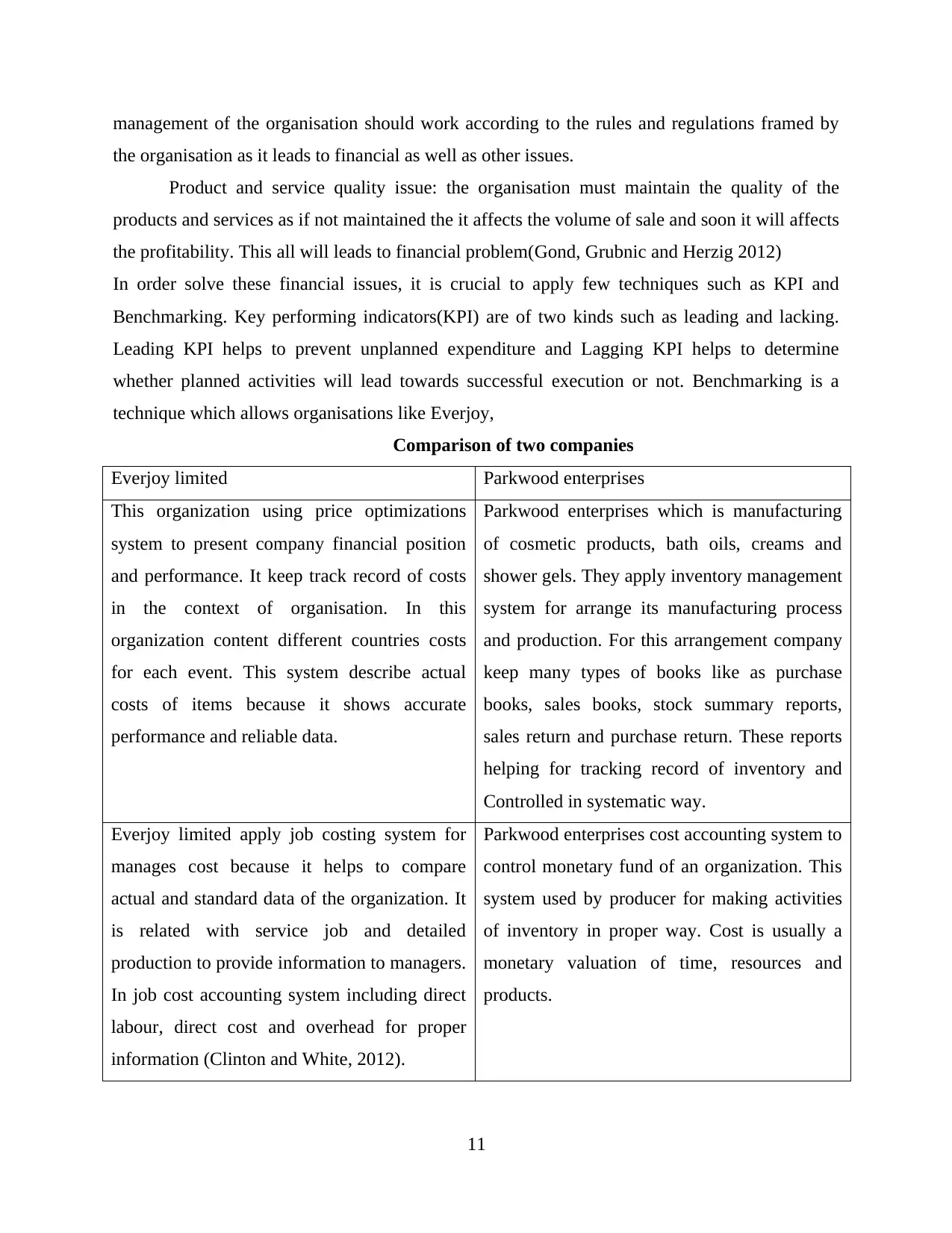
management of the organisation should work according to the rules and regulations framed by
the organisation as it leads to financial as well as other issues.
Product and service quality issue: the organisation must maintain the quality of the
products and services as if not maintained the it affects the volume of sale and soon it will affects
the profitability. This all will leads to financial problem(Gond, Grubnic and Herzig 2012)
In order solve these financial issues, it is crucial to apply few techniques such as KPI and
Benchmarking. Key performing indicators(KPI) are of two kinds such as leading and lacking.
Leading KPI helps to prevent unplanned expenditure and Lagging KPI helps to determine
whether planned activities will lead towards successful execution or not. Benchmarking is a
technique which allows organisations like Everjoy,
Comparison of two companies
Everjoy limited Parkwood enterprises
This organization using price optimizations
system to present company financial position
and performance. It keep track record of costs
in the context of organisation. In this
organization content different countries costs
for each event. This system describe actual
costs of items because it shows accurate
performance and reliable data.
Parkwood enterprises which is manufacturing
of cosmetic products, bath oils, creams and
shower gels. They apply inventory management
system for arrange its manufacturing process
and production. For this arrangement company
keep many types of books like as purchase
books, sales books, stock summary reports,
sales return and purchase return. These reports
helping for tracking record of inventory and
Controlled in systematic way.
Everjoy limited apply job costing system for
manages cost because it helps to compare
actual and standard data of the organization. It
is related with service job and detailed
production to provide information to managers.
In job cost accounting system including direct
labour, direct cost and overhead for proper
information (Clinton and White, 2012).
Parkwood enterprises cost accounting system to
control monetary fund of an organization. This
system used by producer for making activities
of inventory in proper way. Cost is usually a
monetary valuation of time, resources and
products.
11
the organisation as it leads to financial as well as other issues.
Product and service quality issue: the organisation must maintain the quality of the
products and services as if not maintained the it affects the volume of sale and soon it will affects
the profitability. This all will leads to financial problem(Gond, Grubnic and Herzig 2012)
In order solve these financial issues, it is crucial to apply few techniques such as KPI and
Benchmarking. Key performing indicators(KPI) are of two kinds such as leading and lacking.
Leading KPI helps to prevent unplanned expenditure and Lagging KPI helps to determine
whether planned activities will lead towards successful execution or not. Benchmarking is a
technique which allows organisations like Everjoy,
Comparison of two companies
Everjoy limited Parkwood enterprises
This organization using price optimizations
system to present company financial position
and performance. It keep track record of costs
in the context of organisation. In this
organization content different countries costs
for each event. This system describe actual
costs of items because it shows accurate
performance and reliable data.
Parkwood enterprises which is manufacturing
of cosmetic products, bath oils, creams and
shower gels. They apply inventory management
system for arrange its manufacturing process
and production. For this arrangement company
keep many types of books like as purchase
books, sales books, stock summary reports,
sales return and purchase return. These reports
helping for tracking record of inventory and
Controlled in systematic way.
Everjoy limited apply job costing system for
manages cost because it helps to compare
actual and standard data of the organization. It
is related with service job and detailed
production to provide information to managers.
In job cost accounting system including direct
labour, direct cost and overhead for proper
information (Clinton and White, 2012).
Parkwood enterprises cost accounting system to
control monetary fund of an organization. This
system used by producer for making activities
of inventory in proper way. Cost is usually a
monetary valuation of time, resources and
products.
11
Paraphrase This Document
Need a fresh take? Get an instant paraphrase of this document with our AI Paraphraser
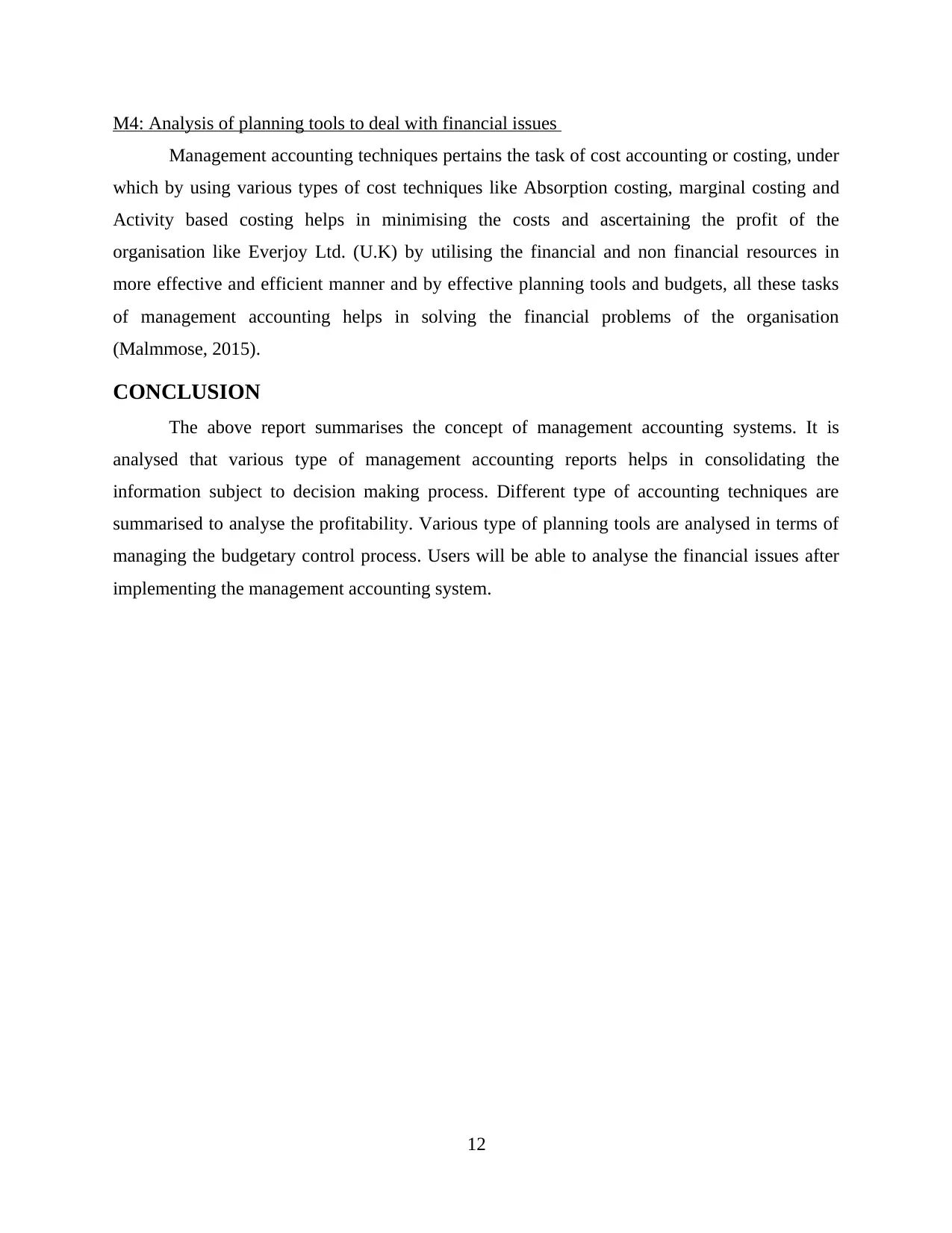
M4: Analysis of planning tools to deal with financial issues
Management accounting techniques pertains the task of cost accounting or costing, under
which by using various types of cost techniques like Absorption costing, marginal costing and
Activity based costing helps in minimising the costs and ascertaining the profit of the
organisation like Everjoy Ltd. (U.K) by utilising the financial and non financial resources in
more effective and efficient manner and by effective planning tools and budgets, all these tasks
of management accounting helps in solving the financial problems of the organisation
(Malmmose, 2015).
CONCLUSION
The above report summarises the concept of management accounting systems. It is
analysed that various type of management accounting reports helps in consolidating the
information subject to decision making process. Different type of accounting techniques are
summarised to analyse the profitability. Various type of planning tools are analysed in terms of
managing the budgetary control process. Users will be able to analyse the financial issues after
implementing the management accounting system.
12
Management accounting techniques pertains the task of cost accounting or costing, under
which by using various types of cost techniques like Absorption costing, marginal costing and
Activity based costing helps in minimising the costs and ascertaining the profit of the
organisation like Everjoy Ltd. (U.K) by utilising the financial and non financial resources in
more effective and efficient manner and by effective planning tools and budgets, all these tasks
of management accounting helps in solving the financial problems of the organisation
(Malmmose, 2015).
CONCLUSION
The above report summarises the concept of management accounting systems. It is
analysed that various type of management accounting reports helps in consolidating the
information subject to decision making process. Different type of accounting techniques are
summarised to analyse the profitability. Various type of planning tools are analysed in terms of
managing the budgetary control process. Users will be able to analyse the financial issues after
implementing the management accounting system.
12
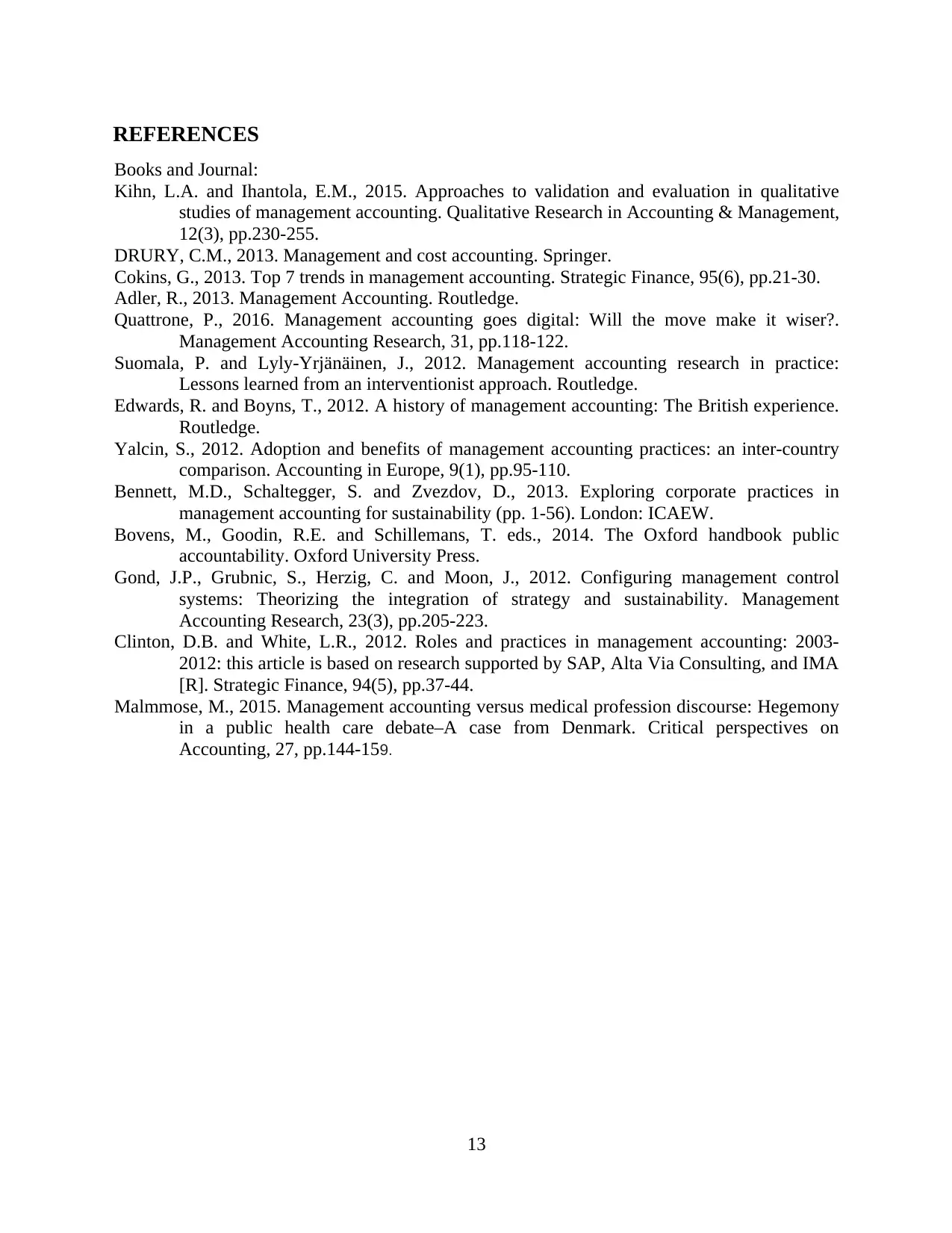
REFERENCES
Books and Journal:
Kihn, L.A. and Ihantola, E.M., 2015. Approaches to validation and evaluation in qualitative
studies of management accounting. Qualitative Research in Accounting & Management,
12(3), pp.230-255.
DRURY, C.M., 2013. Management and cost accounting. Springer.
Cokins, G., 2013. Top 7 trends in management accounting. Strategic Finance, 95(6), pp.21-30.
Adler, R., 2013. Management Accounting. Routledge.
Quattrone, P., 2016. Management accounting goes digital: Will the move make it wiser?.
Management Accounting Research, 31, pp.118-122.
Suomala, P. and Lyly-Yrjänäinen, J., 2012. Management accounting research in practice:
Lessons learned from an interventionist approach. Routledge.
Edwards, R. and Boyns, T., 2012. A history of management accounting: The British experience.
Routledge.
Yalcin, S., 2012. Adoption and benefits of management accounting practices: an inter-country
comparison. Accounting in Europe, 9(1), pp.95-110.
Bennett, M.D., Schaltegger, S. and Zvezdov, D., 2013. Exploring corporate practices in
management accounting for sustainability (pp. 1-56). London: ICAEW.
Bovens, M., Goodin, R.E. and Schillemans, T. eds., 2014. The Oxford handbook public
accountability. Oxford University Press.
Gond, J.P., Grubnic, S., Herzig, C. and Moon, J., 2012. Configuring management control
systems: Theorizing the integration of strategy and sustainability. Management
Accounting Research, 23(3), pp.205-223.
Clinton, D.B. and White, L.R., 2012. Roles and practices in management accounting: 2003-
2012: this article is based on research supported by SAP, Alta Via Consulting, and IMA
[R]. Strategic Finance, 94(5), pp.37-44.
Malmmose, M., 2015. Management accounting versus medical profession discourse: Hegemony
in a public health care debate–A case from Denmark. Critical perspectives on
Accounting, 27, pp.144-159.
13
Books and Journal:
Kihn, L.A. and Ihantola, E.M., 2015. Approaches to validation and evaluation in qualitative
studies of management accounting. Qualitative Research in Accounting & Management,
12(3), pp.230-255.
DRURY, C.M., 2013. Management and cost accounting. Springer.
Cokins, G., 2013. Top 7 trends in management accounting. Strategic Finance, 95(6), pp.21-30.
Adler, R., 2013. Management Accounting. Routledge.
Quattrone, P., 2016. Management accounting goes digital: Will the move make it wiser?.
Management Accounting Research, 31, pp.118-122.
Suomala, P. and Lyly-Yrjänäinen, J., 2012. Management accounting research in practice:
Lessons learned from an interventionist approach. Routledge.
Edwards, R. and Boyns, T., 2012. A history of management accounting: The British experience.
Routledge.
Yalcin, S., 2012. Adoption and benefits of management accounting practices: an inter-country
comparison. Accounting in Europe, 9(1), pp.95-110.
Bennett, M.D., Schaltegger, S. and Zvezdov, D., 2013. Exploring corporate practices in
management accounting for sustainability (pp. 1-56). London: ICAEW.
Bovens, M., Goodin, R.E. and Schillemans, T. eds., 2014. The Oxford handbook public
accountability. Oxford University Press.
Gond, J.P., Grubnic, S., Herzig, C. and Moon, J., 2012. Configuring management control
systems: Theorizing the integration of strategy and sustainability. Management
Accounting Research, 23(3), pp.205-223.
Clinton, D.B. and White, L.R., 2012. Roles and practices in management accounting: 2003-
2012: this article is based on research supported by SAP, Alta Via Consulting, and IMA
[R]. Strategic Finance, 94(5), pp.37-44.
Malmmose, M., 2015. Management accounting versus medical profession discourse: Hegemony
in a public health care debate–A case from Denmark. Critical perspectives on
Accounting, 27, pp.144-159.
13
1 out of 15
Related Documents
Your All-in-One AI-Powered Toolkit for Academic Success.
+13062052269
info@desklib.com
Available 24*7 on WhatsApp / Email
![[object Object]](/_next/static/media/star-bottom.7253800d.svg)
Unlock your academic potential
© 2024 | Zucol Services PVT LTD | All rights reserved.





